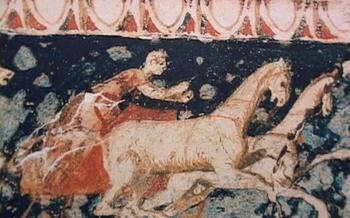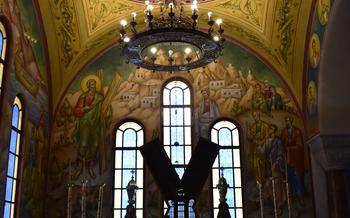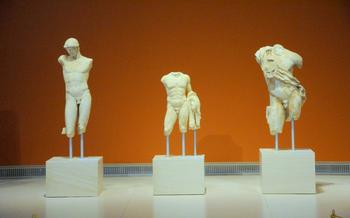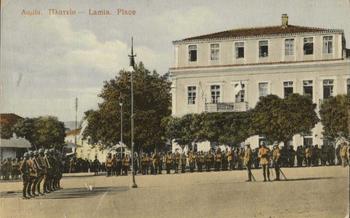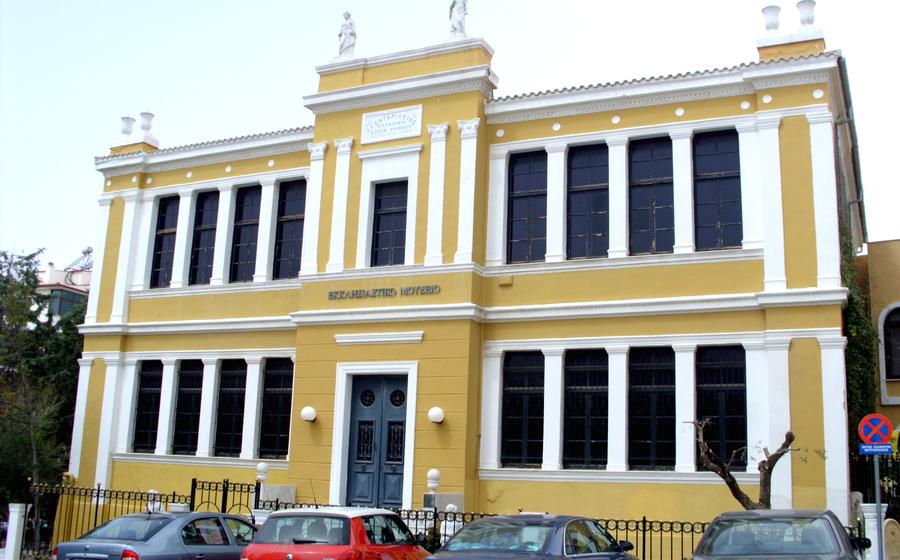
Villa Claudia – Roman Estate in Didymoteicho
- Villa Claudia - A Historical Overview
- Mosaics of Villa Claudia
- Exploring the Villa's Ruins
- Location and Accessibility
- Admission and Visiting Hours
- Guided Tours and Audio Guides
- Exhibitions and Displays
- Photography and Videography
- Souvenirs and Gift Shop
- Accessibility for Visitors with Disabilities
- Surrounding Attractions
- Local Cuisine and Dining Options:
- Accommodations in Didymoteicho
- Safety and Security:
- Insider Tip: Unraveling the Secrets of Villa Claudia
Villa Claudia - A Historical Overview
In the heart of Didymoteicho, nestled amidst verdant landscapes, lies the captivating Villa Claudia, a testament to ancient Roman grandeur. This sprawling estate, dating back to the 4th century AD, was once the opulent residence of Claudia Terentia Magna, a prominent Roman aristocrat.
The villa's origins can be traced to the glory days of the Roman Empire, when wealthy families sought refuge in rural retreats beyond the bustling cities. Villa Claudia served as a sanctuary for Claudia and her entourage, a place to escape the political turmoil and embrace the tranquility of nature.
The architectural design of the estate reflects the sophisticated taste and opulence of its inhabitants. Constructed with meticulous precision using local materials, the villa boasts a harmonious blend of functionality and aesthetics. Its spacious rooms, intricate mosaics, and private baths reveal the attention to detail and luxurious lifestyle enjoyed by the Roman elite.
Excavations conducted at the site have unearthed a treasure trove of artifacts and insights into the lives of those who once graced these halls. From elegant marble sculptures to intricate pottery, these discoveries provide glimpses into the artistic and cultural pursuits of the villa's residents.
Mosaics of Villa Claudia
The Villa Claudia is renowned for its exceptionally well-preserved and intricate mosaic floors. These mosaics, created using colorful tesserae, depict a variety of themes and narratives that offer a glimpse into the lives and beliefs of the Roman inhabitants.
The most striking mosaic is the central panel in the triclinium, or dining room. It portrays the abduction of Persephone by the god Hades, a powerful and dramatic scene from Greek mythology. The mosaic is executed with great skill and attention to detail, capturing the emotions and expressions of the characters.
Other mosaics throughout the villa depict scenes of everyday life, such as hunting, fishing, and agricultural activities. These mosaics provide valuable insights into the economic and social life of the Roman estate. They also feature geometric patterns and decorative motifs, adding to the overall aesthetic beauty of the villa.
The techniques and materials used in creating the mosaics are also noteworthy. The tesserae, or small tiles, are made from a variety of materials, including marble, limestone, and colored glass. The artists used a variety of techniques to create the intricate designs, including opus tessellatum, where the tesserae are arranged in regular patterns, and opus vermiculatum, where the tesserae are arranged in irregular patterns to create more complex and detailed images.
The mosaics of Villa Claudia are not only visually stunning but also offer a rich source of information about Roman art, culture, and mythology. They provide a glimpse into the worldview of the Roman aristocrats who once resided in this opulent estate.
Exploring the Villa's Ruins
Step into the preserved sections of Villa Claudia and embark on a journey through time. Explore the remains of opulent living quarters, bathing facilities, and various other structures that once formed this grand estate. As you wander through these ruins, you'll gain a glimpse into the daily life and customs of Roman aristocrats who once called this place home.
The preserved sections of the villa allow visitors to explore the intricate layout of the estate. Admire the well-preserved mosaic floors that adorn many of the rooms, each telling a unique story through its vibrant colors and detailed imagery. Discover the remains of kitchens, dining rooms, and living areas, offering a glimpse into the domestic life of the villa's inhabitants.
Don't miss the impressive bathing facilities, with their well-preserved pools, heating systems, and intricate plumbing. These luxurious bathing areas provide insights into the Romans' emphasis on hygiene and self-care.
As you explore the ruins of Villa Claudia, let your imagination transport you back to a time of grandeur and opulence. Picture the villa's inhabitants going about their daily lives, hosting lavish banquets, and enjoying the comforts of this magnificent estate.
Location and Accessibility
Villa Claudia is situated in the picturesque town of Didymoteicho, in northeastern Greece. To reach this historical site, visitors can opt for various transportation options. The villa is conveniently accessible by car, allowing travelers to explore the region at their own pace. For those without a vehicle, public transportation is also available, with buses departing regularly from major cities like Alexandroupolis and Orestiada. Once in Didymoteicho, the villa is just a short walk or taxi ride from the town center, making it easy to combine the exploration of Villa Claudia with other attractions in the area. The proximity to other historical landmarks, such as the Byzantine Fortress and the Archaeological Museum of Didymoteicho, invites visitors to delve deeper into the rich cultural heritage of the region.
Admission and Visiting Hours
Admission to Villa Claudia is subject to a nominal fee, with concessions for students, seniors, and families. The villa's operating hours vary seasonally, typically opening from morning until late afternoon. During peak tourist season, extended hours may be implemented to accommodate increased visitor traffic.
To ensure a peaceful and enjoyable visit, it's advisable to plan your visit outside of peak hours, particularly during the summer months. This will allow you to avoid crowds, take your time exploring the ruins, and fully appreciate the intricate details of the mosaics.
Guided Tours and Audio Guides
Enhance your visit to Villa Claudia by taking advantage of the guided tours offered in various languages. These tours, led by knowledgeable guides, provide in-depth insights into the history, architecture, and significance of the estate. Learn about the Roman aristocratic family that once resided here, the construction techniques used, and the daily life of the inhabitants. Highlights of the guided tours include the stunning mosaic floors, the preserved living quarters, and the remains of the baths.
For those who prefer a more independent exploration, audio guides are available in multiple languages. These self-guided tours allow you to explore the villa at your own pace, listening to informative commentary about each section. The audio guides provide a wealth of information, ensuring that you don't miss any of the important details and stories associated with Villa Claudia.
Exhibitions and Displays
Villa Claudia also houses several informative exhibitions and displays that showcase the rich history and cultural significance of the site. These exhibits provide visitors with a deeper understanding of the Roman estate and its inhabitants.
-
Artifacts and Excavations:
-
Display cases exhibit artifacts recovered during the excavations, such as ceramic vessels, coins, jewelry, and tools. These objects offer glimpses into the daily lives and customs of the Roman aristocrats who once resided in the villa.
-
Interactive Displays:
-
Interactive touchscreens and multimedia presentations allow visitors to explore the villa's history, architecture, and mosaics in a more engaging way. They can zoom in on details, view 3D models, and learn about the latest research findings.
-
Conservation Efforts:
-
The exhibits also highlight the ongoing conservation and restoration work being carried out at the site. Visitors can learn about the techniques used to preserve the mosaics and other structures, ensuring their legacy for future generations.
Photography and Videography
Photography and videography enthusiasts are welcome to capture the beauty of Villa Claudia through their lenses. However, it is important to respect the historical significance of the site and adhere to the following guidelines:
-
Respectful Photography: Avoid using flash photography, as it can damage the delicate mosaics and artifacts.
-
Capture the Essence: Focus on capturing the intricate details and vibrant colors of the mosaics, as well as the grandeur of the architectural remains.
-
Wide-Angle Views: Utilize wide-angle lenses to capture the expansive spaces and panoramic views of the villa.
-
Drone Photography: Drone photography is not permitted within the villa's premises to ensure the safety and preservation of the site.
Souvenirs and Gift Shop
At the Villa Claudia, you can discover a charming souvenir shop that offers a unique selection of items inspired by the villa's rich history and stunning mosaics. Browse through an array of souvenirs, including replicas of the intricate mosaic tiles, postcards featuring breathtaking views of the estate, and books delving into the fascinating history of the Roman villa.
Support local artisans and preserve cultural traditions by purchasing handcrafted souvenirs that celebrate the region's rich heritage. Choose from hand-painted ceramics adorned with mosaic motifs, jewelry inspired by ancient Roman designs, and textiles featuring traditional patterns. Each item tells a story, allowing you to carry a piece of the villa's legacy with you long after your visit.
Accessibility for Visitors with Disabilities
Villa Claudia recognizes the importance of accessibility for visitors with disabilities. To ensure an inclusive and welcoming environment, the site has implemented thoughtful accessibility features. Wheelchair-accessible paths and ramps have been carefully designed to navigate the terrain smoothly. Visitors with limited mobility can explore the villa's ruins and exhibits comfortably, without any barriers. The staff at Villa Claudia is dedicated to providing assistance and support to all visitors, ensuring that everyone can have a fulfilling and enriching experience.
Surrounding Attractions
Cultural Tapestry of Didymoteicho:
Beyond the confines of Villa Claudia, Didymoteicho unfolds a rich tapestry of cultural attractions. The town's history is intertwined with different civilizations, leaving behind a legacy of architectural wonders and museums. Explore the Byzantine Castle, a testament to the town's strategic importance during the Middle Ages. Delve into the Folklore Museum, showcasing the traditions and customs of the region. Discover the Archaeological Museum, housing artifacts unearthed from the Villa Claudia and other nearby sites. Immerse yourself in the vibrant local culture by attending traditional festivals and events, where you can witness traditional dances, music, and cuisine. Didymoteicho offers a harmonious blend of history, culture, and local charm, inviting visitors to explore its diverse heritage.
Local Cuisine and Dining Options:
Immerse yourself in the culinary delights of Didymoteicho, where traditional Greek tavernas and restaurants offer a tantalizing array of regional specialties and local delicacies. Savor the flavors of freshly caught seafood, succulent grilled meats, and mouthwatering pastries, all prepared with local ingredients and infused with the warmth of Greek hospitality. Indulge in the region's signature dishes, such as "giouvetsi" (oven-baked lamb or beef with orzo pasta) and "saganaki" (fried cheese), complemented by a glass of local wine or refreshing ouzo. As you dine, let the aromas and flavors transport you back in time, connecting you to the rich history and vibrant culture of this ancient land. Embark on a culinary journey that complements your historical exploration, creating a truly immersive and unforgettable experience.
Accommodations in Didymoteicho
Didymoteicho offers a range of accommodation options for visitors who wish to delve deeper into the town's history and charm. Whether seeking a cozy guesthouse or a modern hotel, there are options to suit every preference and budget. Many of these accommodations are conveniently located near Villa Claudia, allowing for easy access to the ancient estate and other attractions.
For a truly immersive experience, consider staying at a traditional Greek guesthouse. These charming establishments often feature warm hospitality, local cuisine, and a chance to interact with the friendly locals. Alternatively, opt for a modern hotel that offers contemporary amenities and services, ensuring a comfortable and hassle-free stay.
When selecting your accommodation, consider the proximity to Villa Claudia, as well as other attractions you may wish to explore. Some hotels and guesthouses also offer guided tours or excursions to nearby historical sites, providing an opportunity to learn more about the region's rich heritage.
Didymoteicho's accommodations offer a perfect base for exploring the town's many treasures. From charming guesthouses to modern hotels, there are options to suit every traveler's needs. Extend your stay to fully immerse yourself in the town's history, culture, and natural beauty.
Safety and Security:
When visiting Villa Claudia, your safety and security should be a top priority. Here are some essential tips to keep in mind:
-
Stay vigilant and aware of your surroundings. As with any historical site, be cautious of pickpockets or petty theft. Keep your valuables close and avoid displaying them openly.
-
Respect the local customs and traditions. Greece is a welcoming country with a rich cultural heritage. Be respectful of local customs and traditions to ensure a positive experience for both yourself and the community.
-
Follow the guidelines and recommendations provided by the site's staff. They are there to assist you and ensure your safety. Adhere to any posted signs or instructions regarding restricted areas or safety measures.
-
Be mindful of the terrain and uneven surfaces. The villa's ruins and pathways may have uneven surfaces or loose stones. Wear comfortable shoes and be cautious when walking to avoid any accidents.
-
Stay hydrated, especially during the summer months. Greece can experience hot and sunny weather, so it's crucial to stay hydrated. Bring a water bottle or purchase one from the gift shop to avoid dehydration.
Insider Tip: Unraveling the Secrets of Villa Claudia
Beyond the captivating mosaics and ruins, Villa Claudia holds hidden treasures waiting to be discovered. As you wander through the estate, keep an eye out for the intricate carvings adorning the columns and archways. These subtle details offer a glimpse into the artistic prowess of Roman craftsmen.
For a truly unique experience, visit the villa during the annual "Roman Nights" festival, held every summer. This immersive event transports visitors back in time, with actors dressed in Roman attire, traditional music performances, and reenactments of ancient rituals. It's a magical opportunity to witness the villa come alive and experience its history in a captivating way.
Remember, the most rewarding discoveries often come from straying from the beaten path. Take your time, explore every corner, and let the whispers of the past guide you through the enchanting world of Villa Claudia.

